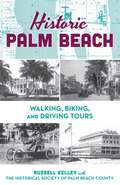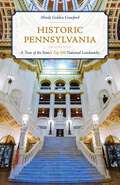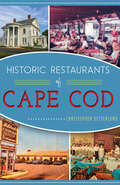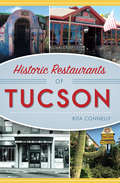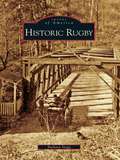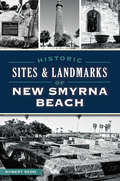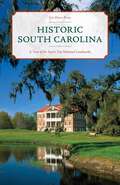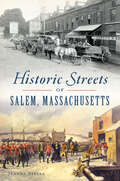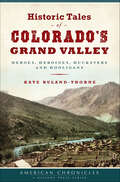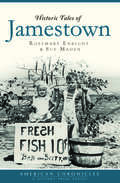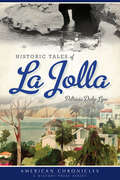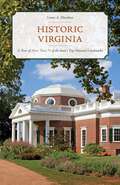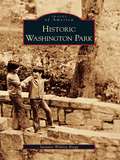- Table View
- List View
Historic Palm Beach: Walking, Biking and Driving Tours
by The Historical Society of Palm Beach County Russell KelleyDiscover the remarkable transformation of Palm Beach through three expertly curated historical tours that bring 150 years of history to life. Step back in time as you explore Palm Beach's evolution from wilderness to wonderland through this unique guide featuring 150 rare vintage photographs from the Historical Society of Palm Beach County's archives. Whether you're a history buff, architecture enthusiast, or curious traveler, this comprehensive guide offers three distinct ways to experience Palm Beach's rich heritage: A 10-mile driving tour showcasing Palm Beach's evolution from Pioneer Era to present day, including optional walking detours to legendary mansions A scenic 5-mile Lake Trail bike tour following the original Pioneer Era pathway along Lake Worth An intimate walking tour through the historic midtown district, revealing the stories behind iconic Worth Avenue and Royal Park Addition From Henry Flagler's magnificent hotels to Addison Mizner's architectural masterpieces, each tour combines detailed maps, historical context, and vintage photographs—many showing lost landmarks like the famed Royal Poinciana Hotel. Experience Palm Beach's fascinating journey from frontier outpost to America's premier resort destination.
Historic Pennsylvania: A Tour of the State's Top 100 National Landmarks
by Mindy Gulden CrawfordHistoric Pennsylvania: A Tour of the State&’s Top 100 National Historic Landmarks is a carefully curated travel guide, written by a local historian, featuring the most intriguing and significant of the state's nationally recognized historic landmarks. This guide provides interesting anecdotes and color photography of famous homes and churches, man-made wonders set amid the splendor of nature, and the crumbling remains of the region's industrial, coal mining past. Tour the Keystone State and travel back in time with Historic Pennsylvania.
Historic Pub Crawls Through London, Vol. 1: 12 Guided Walks Around London's Iconic Pubs and Landmarks - the perfect gift for Father's Day
by Thomas J. VosperAfter spontaneously hosting a birthday pub crawl through London's finest alehouses, Thomas J. Vosper was inundated with requests from friends and family to make it a regular occurrence. And so, Historic Pub Crawls was born; a curated guide of fun, accessible and fact-filled walks which have taken social media by storm.Covering areas such as Greenwich, Kings Cross, London Bridge and Covent Garden, this guide takes you on expertly curated walks through 10-15 historic pubs across the heart of the capital. Sip a pint overlooking Parliament, wander past the ancient Tower of London, enjoy a riverside stroll near Shakespeare's Globe, or take in the stunning sights of St. Paul's Cathedral.Whether you're a history buff, a beer enthusiast, or just up for a great day out, this book is your ticket to unforgettable pub adventures. Grab a copy, gather your mates, and start your crawl!
Historic Pub Crawls Through London, Vol. 1: 12 Guided Walks Around London's Iconic Pubs and Landmarks - the perfect gift for Father's Day
by Thomas J. VosperAfter spontaneously hosting a birthday pub crawl through London's finest alehouses, Thomas J. Vosper was inundated with requests from friends and family to make it a regular occurrence. And so, Historic Pub Crawls was born; a curated guide of fun, accessible and fact-filled walks which have taken social media by storm.Covering areas such as Greenwich, Kings Cross, London Bridge and Covent Garden, this guide takes you on expertly curated walks through 10-15 historic pubs across the heart of the capital. Sip a pint overlooking Parliament, wander past the ancient Tower of London, enjoy a riverside stroll near Shakespeare's Globe, or take in the stunning sights of St. Paul's Cathedral.Whether you're a history buff, a beer enthusiast, or just up for a great day out, this book is your ticket to unforgettable pub adventures. Grab a copy, gather your mates, and start your crawl!
Historic Pub Crawls Through New York: 10 Guided Walks Around New York's Iconic Pubs and Landmarks (Historic Pub Crawls)
by Thomas J. VosperAfter spontaneously hosting a birthday pub crawl through London's finest alehouses, Thomas J. Vosper was inundated with requests from friends and family to make it a regular occurrence. And so, Historic Pub Crawls was born; a curated guide of fun, accessible and fact-filled walks which have taken social media by storm. Now, he's back-bigger, boozier and star-spangled -with Historic Pub Crawls of New York!From quiet, old Irish boozers to bustling dive bars, this guide takes you on expertly curated walks through 10-15 historic pubs across the heart of Manhattan. Stroll along the scenic High Line, dip into lesser known spots in tourist areas such as Times Square and Broadway, or enjoy a drink at some of the United States' oldest drinking establishments in the financial district.Whether you're a history buff, a beer enthusiast, or just up for a great night out, this book is your ticket to unforgettable pub adventures. Grab a copy, gather your mates, and start your crawl!
Historic Ranches of Northeastern New Mexico (Images of America)
by Baldwin G. BurrIn 1866, Charles Goodnight and his partner Oliver Loving began rounding up feral cattle in Texas, forming herds to be driven north into the immense unoccupied grazing land in northeastern New Mexico. The counties of Colfax, Mora, Harding, Union, and San Miguel became the location of some of the great historic ranches of the West. From the 11,000-acre Chase Ranch in Colfax County to the 650,000-acre Bell Ranch in San Miguel County, these ranches have been home to several generations of ranching families. Pioneer ranchers such as Manley M. Chase, Frank and Charles Springer, Samuel Watrous, and Albert K. Mitchell established a tradition of perseverance, self-sufficiency, and sustainable range management that continues to the present day.
Historic Restaurants of Billings (American Palate Ser.)
by Stella Fong Greg PatentBillings exploded when the railroad arrived, and good food was here to stay. Montana Avenue anchored the first establishments serving oysters, chop suey and steaks. Modern comfort arrived with the Northern Hotel and never left. Locals sipped, savored and swung at the Skyline, Bella Vista, Elmo and Windmill Supper Clubs from the 1930s to the 1960s. Entrepreneurs debuted the Level 3 Tea Room, La Toque, Bruno's and New Moon Cafe. Beef still reigns at the Rex, Jake's and Bistecca at the Granary. Writer Stella Fong testifies why names like Yegen, McCormick, Schaer and Honaker have persisted throughout Billings' culinary history.
Historic Restaurants of Cape Code (American Palate)
by Christopher SetterlundA guide to the storied Massachusetts eateries that have left an indelible mark on their customers.Author Christopher Setterlund details the history of the iconic establishments of the Cape, still fresh in the memories of patrons, complete with famous recipes. Bill and Thelma&’s was hugely popular with students from the 1950s to the 1970s, often packed with locals after sporting events and dances. Starbuck&’s Restaurant in Hyannis featured the Chief Justice Warren Burger Burger and the Larry Bird Burger on its menu and boasted of the soup du jour, &“We don't know what it is, but we have it every day.&” Opinions differ on how the Reno Diner actually got its name, whether from a broken sign or a local appliance company. This fun collection is sure to arouse some fond memories of these old eateries, and perhaps a little hunger too.&“Forty chapters—one each for 39 restaurants and another for some recipes—make for a delicious and nostalgic read.&” —Barnstable Patriot
Historic Restaurants of Tucson (American Palate)
by Rita ConnellyTucson's culinary journey began thousands of years ago, when Native American tribes developed an agricultural base along the Santa Cruz River. In modern times, restaurants ranging from tiny taquerias to fine dining spaces all contributed to the local food culture. El Charro, serving Mexican cuisine since 1922, still attracts crowds from all over. Folks head straight to Pat's for a hot dog, Lucky Wishbone for some fried chicken or eegee's for a grinder and a cold, frosty drink. On any given night, the patio at El Corral is filled with diners anticipating their famous prime rib and tamale pie. Local food writer Rita Connelly brings to life the stories of beloved eateries that have endured for decades and continue to delight with incredible flavors.
Historic Restaurants of Washington, D.C.: Capital Eats (American Palate Ser.)
by John DeFerrariDiscover the culinary heritage of America&’s capitol with this guide to Washington, D.C.&’s historic restaurants and storied local eateries. While today&’s foodies enjoy the latest culinary trends of Logan Circle and the H Street corridor, Washington's first true restaurants opened around 1830. Waves of immigrants introduced a global mix of ingredients to the capital&’s eager palates by opening eateries like the venerable China Doll Gourmet and Cleveland Park's Roma Restaurant. By the twentieth century, the variety and quality of cuisine was astounding. Diners could have tea at Garfinckel's Greenbrier or lunch at local favorites such as Little Tavern Diner or Ben's Chili Bowl. For an elegant evening, fine restaurants like Rive Gauche and the Monocle satisfied the most sophisticated gastronome. With careful research and choice recipes, &“Streets of Washington&” blogger John DeFerrari chronicles the culinary and social history of the capital through its restaurants, tasting his way from the lavish Gilded Age dining halls of the Willard Hotel to the Hot Shoppe's triple-decker Mighty Mo.
Historic Roswell Georgia: Georgia (Images of America)
by Rebecca Nash Paden Joe MctyreIn the 1830s and 1840s, low country planters came to Roswell, Georgia, seeking relief from the heat and malaria that plagued Georgia's golden coast. The wealthy plantation owners were attracted to the temperate North Georgia climate by Roswell King-a former Glynn County plantation supervisor, builder, and entrepreneur-who promised his friends free land on which to build their homes and stock in the textile mill he built in 1839. The village of Roswell was laid out in 1840 with wide streets, a park, mills, and a residential area, and a community founded by devout Presbyterians and hard-working industrialists began to take shape. By the onset of the Civil War, Roswell had two cotton mills, a woolen mill, and flour and grist mills nearby. The town's strategic location near the Chattahoochee River made it a target of Union Gen. William T. Sherman during his March to the Sea in 1864. While Federal soldiers occupied Roswell that summer, none of the grand homes of the town were destroyed. Residents persevered the tolls of war and Reconstruction to rebuild mills and strengthen the local economy. A small and rural community through the early part of the 20th century, Roswell experienced phenomenal growth in the latter half of the century to become a bustling Atlanta suburb; yet much of the charm and small-town character remains and thousands of tourists are attracted each year by its beautiful antebellum homes and buildings. These treasured landmarks are the subject of this engaging retrospective, and each snapshot glimpse will illuminate the Roswell of yesteryear.
Historic Rugby
by Barbara StaggThe Rugby colony opened amid great fanfare in 1880 on East Tennessee's sparsely settled and rugged Cumberland Plateau. Famous British author and social reformer Thomas Hughes was the most involved and dedicated of Rugby's Anglo-American founders. He intended Rugby to be a class-free, agrarian community based on cooperative enterprise, culture, and religious freedom. During its first decade, hundreds immigrated to Rugby from the British Isles; hundreds more came from other parts of America. Some stayed briefly, some for years, some for life. More than 60 cottages, villas, and commercial and institutional buildings of distinctive Victorian styles were built during Rugby's early years. Though Rugby was briefly the most thriving community on the northern plateau, many factors prevented realization of Hughes's utopian goals. Rugby today is a rare surviving example of 19th-century utopian community building. The historic town plan, surrounding woodland and rivers, and key original buildings survive, unspoiled by modern development, through committed restoration and preservation. Heritage tourism is bringing new life.
Historic Sites & Landmarks of New Smyrna Beach (Landmarks)
by Robert ReddNew Smyrna Beach is the third-oldest city in Florida behind only St. Augustine and Pensacola. Originally settled by Dr. Andrew Turnbull in 1768, the city accumulated significant, intriguing and stunning monuments to its past. An unusual-looking memorial to world war heroes--a cross, battle helmet and eagle--sits at Riverside Park. One of the oddest sites is a single-stone cemetery with a vault dedicated to the memory of Charles Dummett. Because of the insects that inhabit Ponce Inlet, a well-known landmark was originally named Mosquito Inlet Lighthouse. Local author and historian Robert Redd guides readers through the iconic historical landmarks of "Florida's Secret Pearl."
Historic South Carolina: A Tour of the State's Top National Landmarks
by Lee Davis PerryHistoric South Carolina: A Tour of the State's Top National Landmarks is a carefully curated travel guide, written by a local historian, featuring the most intriguing and significant of the state's nationally recognized historic landmarks. This guide provides interesting anecdotes and color photography of famous manors and plantation houses, centuries-old churches and chapels, and beautiful marshlands of the Low Country. Tour the Palmetto State and travel back in time with Historic South Carolina.
Historic Streets of Salem, Massachusetts (American Chronicles)
by Jeanne StellaWith this informative and easy-to-use guide, the streets of Salem come alive with history at every turn. When most people think of Salem, they think of witchcraft, Nathaniel Hawthorne, and Samuel McIntire. But there is far more to this coastal city&’s rich history. Echoes of lesser-known tales linger along its lanes and avenues, from the mysteries of Chestnut Street to the founding Quakers of Buffum Street. Local historian Jeanne Stella recounts the stories behind some of Salem&’s oldest street names and reveals the hidden histories that reside within. With her colorful and fascinating tales, you can step back in time as you walk down Daniels Street, learn the many firsts that happened on Broad Street, and discover the varied uses of Salem Common.
Historic Tales of Bethlehem, New York (American Chronicles)
by Susan E. LeathBethlehem's bucolic countryside and bustling suburbs reflect the town's rich history. Uncover the stories that shaped the town from its Dutch settlement to today. Nathaniel Adams, along with his wife, Rhogenia, opened a stagecoach inn and became the first postmaster in what is now Delmar. The opening of the Albany and Susquehanna Railroad broadened travel and freight transportation. The LaGrange family farmed the same land for over two centuries and exemplified the region's deep agricultural roots. Suburbs flourished in the region following World War II. Drawing from her articles that first appeared in Our Towne Bethlehem, town historian Susan E. Leath celebrates the enduring community spirit of Bethlehem with this fascinating collection of essays.
Historic Tales of Colorado’s Grand Valley: Heroes, Heroines, Hucksters and Hooligans (American Chronicles)
by Kate Ruland-ThorneColorado's Grand Valley has an extensive geological and human history going back millennia. Franciscan priests worked in tandem with the native Ute people to plot passage through the territory, opening the valley to unprecedented settlement. The region became the playground of enterprising visionaries, murderous outlaws, hooligans and harlots alike. From the gruesome Meeker massacre and its tragic consequences for the Ute nation to the mysterious murder of Sam McMullin and a showdown with the Ku Klux Klan in 1925, uncover the engrossing stories of an unyielding land. Author Kate Ruland-Thorne recounts many of the defining and damning moments throughout Grand Valley history.
Historic Tales of Jamestown (American Chronicles)
by Sue Maden Rosemary EnrightDiscover the fascinating history of Jamestown, from tales of shipwrecks to summer days long past. The town was home to Camps Bailey and Meade, two training facilities for Union troops during the Civil War. When the steam ferries crossed the bay beginning in 1873, people traveled to the island to sample the town's leisure and entertainment opportunities. Beavertail Lighthouse and the breathtaking Clingstone stand as iconic landmarks centuries after their construction. After the Jamestown Bridge opened in 1940, suburban development on the North End mostly replaced the hotels along the waterfront. Local authors Rosemary Enright and Sue Maden reveal stories of Jamestown's past and evolution in this captivating collection of essays.
Historic Tales of La Jolla (American Chronicles)
by Patricia Daly-LipeThe first settlers to arrive here in 1869 purchased 160 acres for two dollars and change. La Jolla attracted artists, architects, writers and scientists over the years, contributing to today’s prized reputation as a valuable world-class destination. Their stories shaped the fascinating history of this seaside village. Pirates and smugglers hid out in Sunny Jim’s Cave. Ellen Browning Scripps, the Godmother of La Jolla, founded institutions and recreation areas for not only La Jollans but also the rest of the world, including the famous Children’s Pool and Scripps Institute of Oceanography. Theodor Geisel derived inspiration for his art from La Jolla’s landscapes and people. Native La Jollan Patricia Daly-Lipe recalls the stories of these and many other people and places that have molded the village of La Jolla into a natural and cultural wonder.
Historic Tales of Windham (American Chronicles)
by Al Letizio Jr. Derek Saffie Rick HolmesThe natural beauty and fertile lands of Windham drew first the Pawtucket Indians and then Scotch-Irish settlers. The town's rich history is full of intriguing stories, including Wallace Fessenden's unscrupulous baseball umpiring, the return of a native son after his burial at sea in Indonesia and the poetic life of the Rustic Bard, Robert Dinsmoor. Tourism boomed as early as the 1850s, when visitors flocked to the waterside temptations of Canobie Lake and later Cobbett's Pond, where eccentric millionaire Edward Searles built his famous castle. Local historian Derek Saffie weaves together a collection of historic stories from the settlement's roots as Nutfield to the town of Windham.
Historic Virginia: A Tour of More Than 75 of the State's Top National Landmarks
by Laura A. MacalusoHistoric Virginia: A Tour of the State&’s Top 75 National Historic Landmarks is a carefully curated travel guide, written by a local historian, featuring the most intriguing and significant of the state's nationally recognized historic landmarks. This guide provides interesting anecdotes and color photography of famous churches, the homes of Founding Fathers, and monuments of natural splendor amid the Blue Ridge Mountains. Tour the Old Dominion State and travel back in time with Historic Virginia.
Historic Washington Park
by Suzanne Wildrey BraggWashington Park and its neighborhood are steeped in history. When the Moravians settled in Salem in 1766, the hills to the south were used for hunting and, eventually, farming. In the late 1880s, when it became fashionable to build homes on elevated land, the bluffs became one of the most desirable residential areas to emerge in the early decades of Winston-Salem's boom. The plan for its development, built around the electric streetcar line, was designed by Jacob Lott Ludlow, who was also responsible for the West End plat. The Washington Park neighborhood became home to many of the area's wealthiest families, as well as the burgeoning middle class. Their lives, traditions, and habits helped shape the future of Winston-Salem. Today Washington Park is known for its grand mansions, nestled among the many bungalows, with superb views of downtown high-rises. The park, with its rolling hills and beautiful trails, provides a playground for the young and old alike. With the North Carolina School of the Arts located next door, the neighborhood is eclectic, elegant, and unique. This diversity has attracted a varied group of residents, all of whom share pride in their home, gardens, and noted creativity.
Historic Washington, DC: A Tour of the District's Top 50 National Landmarks
by Lori WysongLandmarks are the Touchstones of the Meandering TravelerFrom the sites where American democracy was born, to unique archive collections, art galleries, and architectural must-sees in the middle of this bustling city, Washington, DC is home to 75 National Historic Landmarks. Tour the Capital City and travel back in time to discover the unique stories of its history. Carefully curated by a local historian, Historic Washington, DC: A Tour of the District&’s Top 50 National Landmarks is the essential guide to the most memorable historic sites in our nation&’s capital. Whether you are a history enthusiast, a local visitor, or a tourist, there is something for everyone in this guide to Washington, DC&’s past.
Historic West Salem (Images of America)
by Michael L. BrickerWest Salem is located in the southeast corner of Winston-Salem. It has the historical distinction of containing the land that made up the farms and industry of Colonial Salem. While East Salem, the congregational town and village, controlled business and religious interests, West Salem provided the heart, soul, and backbone of the area with the work of its blue-collar residents. The residents produced the food, mills, and industrial interests that allowed the town to function so successfully in its early years. Throughout West Salem's history, it always triumphed over such challenges as wars and the Great Depression. Images of America: Historic West Salem showcases the stories and photographs of the regular folks whose hard work and sacrifice fueled the greatness of our American leaders.
Historical Tours Alexandria, Virginia: Walk the Path of America's Founding Fathers (Touring History)
by Frederick KnopsAlexandria is one of America&’s most important Colonial towns. Sitting in the shadow of the nation&’s capital, it was the home of George Washington, the launching point of the French and Indian war, and the site of the Thomas Jefferson&’s inaugural ball. Alexandria is now the site of hundreds of architecturally and historically significant buildings, streets named after the heroes of America&’s founding, and is home to numerous boutiques and gourmet restaurants. Historical Tours: Alexandria, Virginia takes the reader on an exploration of this storied American city from its beginnings, including the history behind its street names and founding families. Included are biographies, archival photos, maps, and timelines that add further texture to the history of this remarkable place.
